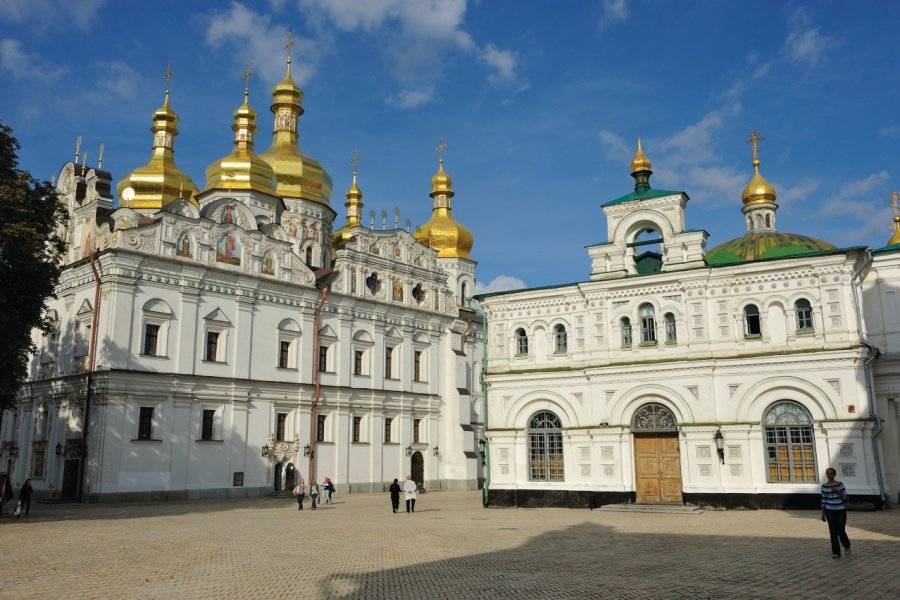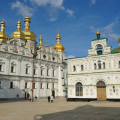LAURE DE PETCHERSK (ПЕЧЕРСЬКА-ЛАВРА ЛАВРА)
To the European visitor, Laure de Petchersk is completely unknown. Yet, for every inhabitant of Ukraine and Russia, he represents one of the largest religious centres. The word laure refers to a principal monastery, the status granted by the Orthodox Patriarchate and that the monastery had the honour of receiving in the th century. In 1051, while the Kiev Rus had just converted to Christianity, two monks, Antoine and his disciple Théodose, founded this monastery, as reported in the Chronicles. As the first cells were dug in caves, this monastery was described as «De» (petchera meaning «cave» in Ukrainian).
The monastery of Petchersk, the first monastery of men, was grade in the th century. The building then divides quickly into two parts: the lower laure, where caves are the first cells of the monks, and high laure. Under the aegis of the princes of Kiev, the monastery is experiencing real development and it is not late to become the most important cultural and spiritual centre of Rus. His contacts with Byzantium allow him to develop architectural techniques, the art of icon and religious songs. National schools are not slow to be founded. After the fragmentation of Kiev's Rus and the mongole-Mongolian invasion that saw the rayonnement of laure extinguished, its activity reappeared in the sixteenth century. With contacts with the West, it introduces among the Slavic peoples that were cut off from all artistic movements coming from Europe, the Baroque, and then the Renaissance arts. In the th and th centuries, laure will become a golden age. All buildings left in plan were being rebuilt during the mongole-Mongolian invasion. The wall is built, the main door. Finally, Ukraine's first printing machine is opened, which is not surprising in the art of engraving. In 1632, it became the first Western-type university, which formed generations of Ukrainians in the Cicero. The bodies of 10 monks were kept in the caves of their first cells, and the natural conditions of the cave (temperature and ventilation) allowed them to momifier and keep. This explains, of course, why laure has now become one of the largest centres of Orthodox pilgrimage. Pilgrims from Ukraine, Russia and other countries of the former USSR are constantly drifting to see the "miracle" of mummified saints.
Tall laure. Extending to 24 ha, laure is visited by commençant high, at the entrance to which tickets can be bought. First of all, the portal is crossed, which makes it possible to see that the wall is 8 m thick. Once the porch is crossed, a plan can be found. On the left and right you can see the buildings attached to the monks'cells. The first church on the left, the church of La Trinité-sur-le-Porche (Троїцька надбрамна церква), built in 1108 and renovated by Pierre the Great in the th century. The entrance surprises the splendor of the mural paintings, dating from the th century. Once returned to the main hall, you can admire on the right wall, in front of the iconostasis, a painting representing the first Ecumenical Council, the Nicaea Council (325). By looking at the iconostasis, one can see the left of the Virgin to the child, to the right, the almighty God, and to the second battant on the right, the painting which, as in any Orthodox church, gives the church name. Before exiting the main part, don't forget to look at the painting above the porch, representing the merchants of the Temple. The church of the Dormition (Успенський собор) is the main building of the upper laure. Destroyed in 1941, this church dating back to 1078 was rebuilt, and a huge piece of original stone was exposed to the cathedral. Next to the church is the steeple (Дзв i ниця). In high laure, two museums among the various museums are worthy of the highest interest. The Historical Museum of Treasures of Ukraine (Музей i сторичних коштовносетй) and the Miniatures Museum (Музей m i кром i hadžić i атюр). There is no need to ask why this museum is located in the religious centre of Kiev: Artist Siarditsy embarked on a very surprising art, the miniature, which seems to delight generations of Ukrainians. The artist represents the most intrusive objects on a microscopic scale, such as a small chip with gilded hooves. Playful and relaxing, this museum will delight visitors who want to leave the spiritual atmosphere of.
Bass bass. From high laure, galleries lead to the caves of laure decline. The entrance to the «nearby caves» (Вх i ä there ближн i печери, open from 1700-1704 to) lies inside the Khrestovozdvizhenska church (Хрестовоздвиженська церква,). The entrance is free, you only pay the candle that will enlighten you. In this cave is the first cell of the monks. The descent into this pilgrimage place is a great moment of spiritual contemplation with sacred mummies. The fervour of pilgrims gathered in this liturgical darkness reminds us how much from Kiev's Premier, the first cradle of Slavs, religion has ceased to be a beacon of hope and rally for Russians and Ukrainians during often troubled periods. Here we keep 79 bodies. The «distant caves» (Вх i ä there дальн i печери, open from 8 h 30 to 16 h 30) pass through the church of the conception of Sainte-Anna (A ннозачат iï вська церква). Here you can find bodies of mummified monks and three underground churches.
Do not leave laure without admiring the panorama that opens on the Dnipro River, the forests and the city, whether from upper laure or bass laure.
Within the laure there is an office that organizes two-hour excursions in different languages (Екскурс i йне бюро). It is on the left after the main entrance for high laure.
In front of Hippocrates you can see the monument to Ukrainian soldiers who died during the war in Afghanistan in the 1980 s. Many very young Ukrainian conscripts found death there.
Did you know? This review was written by our professional authors.
Members' reviews on LAURE DE PETCHERSK (ПЕЧЕРСЬКА-ЛАВРА ЛАВРА)
The ratings and reviews below reflect the subjective opinions of members and not the opinion of The Little Witty.









